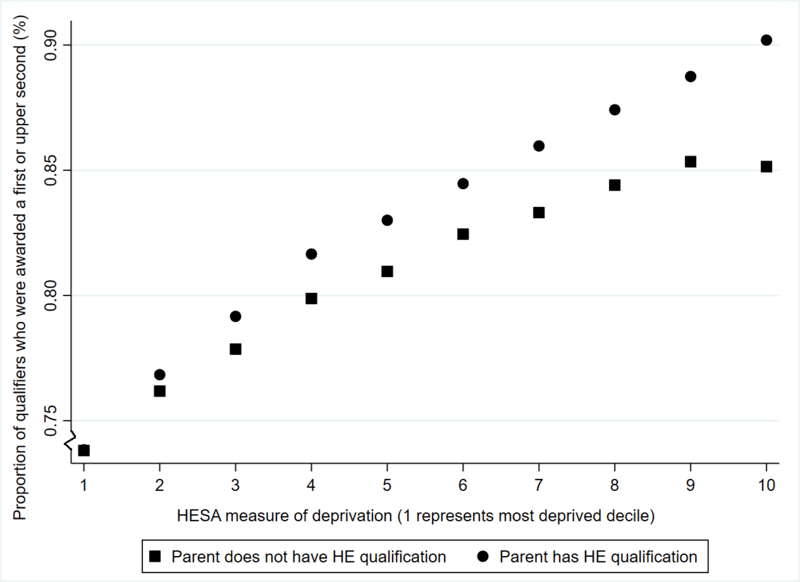Location, location, location: An examination into the value of place-based measures in widening participation
In this insight, HESA researchers look at how the association between neighbourhood deprivation and degree attainment differs by family background. They discuss the implications of the results in relation to the use of area-based measures in widening participation activity.
 Summary and key findings
Summary and key findings
- Previous research in the widening participation field has indicated that a drawback of area-based measures is that they do not necessarily reflect the individual circumstances faced by a (prospective) student.
- Though students may live in a locality classified as more deprived, their family income/education levels could be high, meaning they may not require additional help in the form of outreach activity or greater support during their studies.
- Using area-based measures could therefore lead to policy being ineffectively targeted and thus prevent the objective of equal opportunity for all being achieved.
- There is, however, the possibility that living in a deprived neighbourhood inhibits your ability to reach your potential regardless of your personal situation.
- By investigating how the association between neighbourhood deprivation (using the HESA measure[1]) and degree attainment varies by family background (i.e. parental education), we explore these two viewpoints from an empirical perspective.
- The data reveals two key results;
- Irrespective of whether or not the individual’s parents held higher education qualifications, those from the most deprived deciles were less likely to be awarded a first or upper second class degree.
- There is little disparity in the degree outcomes of those from the most deprived deciles by family background.
- On the basis of these findings, one cannot rule out the possibility that a ‘neigbourhood effect’ exists which leads to those from the most deprived areas being unable to fulfil their abilities regardless of their household conditions.
- The evidence presented here therefore suggests that we should not dismiss the potential value of area-based measures in widening participation activity. Further research using alternative area and individual indicators should be undertaken in this space to see if similar conclusions emerge.
Introduction
Since 2021 we have been working on creating a new area-based measure of deprivation, which attempts to address some of the known drawbacks of the Indices of Deprivation – namely that they are not UK-wide and do not effectively capture deprivation in rural locations.[2]
Existing work on potential indicators that either are or might be used in widening participation activity tends to note that area-based measures do not necessarily inform us of the circumstances facing particular individuals/households. For example, Vikki Boliver and colleagues state that the ‘average characteristics of those living in the same broad locale may be a poor proxy for the characteristics of a given individual’.[3] That is, within a deprived neighbourhood, there may well be households who, for example, have a high income or where both parents have degree-level qualifications. Consequently, they may not necessarily require additional assistance in the form of outreach work or greater support whilst studying. On the other hand, there could be families who are experiencing financial difficulty and would potentially benefit from more help, despite being located in an area that is classified as less deprived. Consequently, they consider that using area-based measures in widening participation could increase the risk that support is not effectively steered towards those that most need it. The overall implication of this is that using area-based measures may inhibit the ability to meet the policy aim of ensuring there is equal opportunity for all. Boliver and colleagues therefore encourage the use of verified individual-level measures, such as free school meal eligibility.
However, there are also arguments in favour of deploying area-based measures. Firstly, there is the view that living in a deprived neighbourhood could hinder a student’s ability to reach their educational potential irrespective of their individual circumstances (e.g. due to the area not having the infrastructure/facilities that enables one to realise their talent, such as good quality housing). Secondly, a key policy objective across all nations of the UK is to reduce inequalities within and between regions, with higher education anticipated to play a key role by helping to develop skills in our most deprived communities. Tackling spatial disparities and helping to promote greater social justice within society is likely to require providers to use area-based measures. Indeed, this is a key reason why Peter Scott (the former Commissioner for Fair Access in Scotland) has previously advocated for the use of area-based indicators, noting that utilising individual-level measures alone may lead to consequences such as neighbourhoods experiencing multiple forms of deprivation losing highly capable young people and social/economic inequalities not being addressed.[4]
The purpose of this insight will be to empirically investigate these views further by evaluating the association between neighbourhood deprivation (utilising the HESA measure) and degree attainment in higher education, as well as how this varies based on individual circumstances (using parental education). By doing so, we follow the recommendation in the Commissioner for Fair Access annual report of 2019, which suggests analysing area and individual-based measures in combination for research purposes.
To date, there are few studies that have brought together area and individual-based measures to assess educational outcomes. In one of the few papers to look at this topic, Emily McDool examines whether the impact of neighbourhoods on Key Stage 4 attainment varies based on the education levels of the parents.[5] From her analysis, she concludes that ‘it is not only children from deprived and uneducated families who fail to reach their potential within deprived neighbourhoods, it is more so the children of educated parents who may potentially be more able but suffer educational losses due to the neighbourhood in which they live’.
Thus, investigating the role of area and individual-based measures in combination (as we do in this insight) is an important matter to consider from the perspective of designing effective widening participation policy in higher education. For instance, if the patterns in Key Stage 4 attainment reported by McDool also emerged when analysing degree outcomes in higher education, an increasing reliance within the sector on individual-based measures alone (e.g. free school meal eligibility, parental education etc) could lead to some prospective students missing out on extra support in spite of their educational chances having been limited by growing up in deprived circumstances.
Data
In conducting this study, we wanted to ensure that the analysis joining an area and individual-based measure was UK-wide in nature. Given that the eligibility criteria for free school meals differs across the UK nations, this wouldn’t be a suitable variable for this investigation. Household income information, which might have been an alternative measure, is not currently available to us in our records. However, within the UCAS application form – which the majority of prospective students across all four home countries will complete when looking to secure a place on an undergraduate course – individuals are requested to supply data about the qualifications held by their parents, with the same question (provided in italics below) asked to all applicants.
Do any of your parents, step-parents or guardians have any higher education qualifications, such as a degree, diploma or certificate of higher education?
One of the concerns that has typically been raised about this field is that it is self-reported and hence it is possible that the response provided is not accurate. However, our previous work exploring the reliability of the field has not indicated that the variable may be of poor quality.[6] Consequently, as parental education data can be considered to be a UK-wide variable, this is the individual measure that we rely upon for our exploration, alongside the HESA measure of deprivation.
The sample we generate for our analysis consists of UK-domiciled full-time first degree students who began their programme of study at the age of 17, 18, 19 or 20 and subsequently qualified in one of the academic years between 2017/18 and 2020/21. Individuals with unclassified degrees are excluded from the investigation, as are those who stated that they did not know whether their parents held higher education qualifications, preferred not to disclose this information or provided no response to this question altogether. Furthermore, those who studied in further education colleges in England, Scotland or Northern Ireland are also not included in the sample, as we do not hold data for these students within our administrative records at present.
Table A1 illustrates the association between our measure of deprivation and parental education. In the most deprived deciles of our measure, we see a higher proportion of individuals report that their parents did not hold higher education qualifications. With previous research indicating that education is a key determinant of whether an individual/family will have persistently low income (thereby increasing the chances of experiencing multiple forms of deprivation), the findings observed in Table A1 are as one might anticipate.[7]
Results
Before presenting the results, it is perhaps useful to outline what we might predict to see should a ‘neighbourhood effect’ (i.e. the neighbourhood one grows up in impacts on their ability to reach their full educational potential) possibly exist. Firstly, irrespective of household background, we should observe a clear association between the HESA area-based measure and degree attainment. That is, the proportion of individuals awarded a first or upper second should increase as we move from the most deprived decile to that representing the least deprived areas. Furthermore, this pattern should emerge for the sub-set of individuals who have at least one parent with a higher education qualification, as well as within the group whose parents do not hold such qualifications. Secondly, among those individuals in the most deprived deciles, the proportion of qualifiers being awarded a first or upper second may be expected to show little variation by parental background if neighbourhoods do indeed influence one’s ability to fulfil their potential.
Figure 1 illustrates the association between our area-based measure of deprivation and degree attainment (i.e. the proportion of qualifiers who are awarded a first or upper second), as well as how this varies by parental education.

Figure 1: The association between the HESA area-based measure of deprivation and degree attainment by family background (i.e. parental education). The sample we draw upon for our analysis consists of UK-domiciled full-time first degree students who began their programme of study at the age of 17, 18, 19 or 20 and subsequently qualified in one of the academic years between 2017/18 and 2020/21. Underlying data can be found in Tables A2 and A3 in the accompanying appendix.
There are two key findings here that should be noted:
1. Firstly, regardless of whether or not the parent(s) of the student held higher education qualifications, living in a more deprived neighbourhood is correlated with a lower likelihood of being awarded a first or upper second class degree.
2. In the most deprived deciles of our area-based measure, there is little difference in attainment by parental education.
These results therefore suggest that we cannot discard the possibility that living in a deprived area contributes to individuals not being able to realise their abilities.
Given our findings, it is also useful at this point to consider the implications of relying solely on individual-level indicators for widening participation activity in this scenario. Those students residing in an area that falls into deciles 1 or 2 of our measure, but with parents who do have higher education qualifications, would be classified as being ineligible for additional support. This is despite these individuals displaying lower attainment than those whose parents don’t have higher education qualifications, but who lived in a less deprived neighbourhood prior to beginning their course. Consequently, resources could be misallocated, thus reducing the chances for the sector to provide equal opportunity for all.
Concluding remarks
Recent years have seen growing levels of attention being given to assessing the value of area and individual-level measures in supporting widening participation activity. We have attempted to add to the literature here by conducting a UK-wide analysis that combines an area (HESA measure of deprivation) and individual (parental education) indicator.
The key take-away message from our exploration is that we cannot dismiss the view that living in a deprived neighbourhood may inhibit individuals from achieving their potential regardless of household background. Consequently, one cannot rule out the value of area-based measures to widening participation work.
Rather, there is a need to carry out further research in this area by utilising other individual measures (e.g. household income) in combination with area-based indicators, as well as looking at a wider range of points in the student/graduate lifecycle (e.g. non-continuation and early career outcomes).
[1] The HESA area-based measure of deprivation has been derived using Census 2011 data and is constructed using small area data on the proportion of residents with below degree-level qualifications and in professional/managerial roles. Further information can be found at https://www.hesa.ac.uk/insight/08-11-2022/new-area-based-measure-deprivation-summary.
[4] https://www.gov.scot/binaries/content/documents/govscot/publications/corporate-report/2019/06/commissioner-fair-access-annual-report-2019-building-progress-towards-fair-access/documents/building-progress-towards-fair-access-annual-report-2019/building-progress-towards-fair-access-annual-report-2019/govscot%3Adocument/building-progress-towards-fair-access-annual-report-2019.pdf

Tej Nathwani

Jenny Stinchcombe
Contents
- Insight
- Appendix
